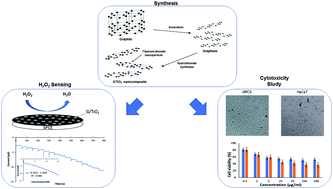One-step green hydrothermal synthesis of biocompatible graphene/TiO2 nanocomposites for non-enzymatic H2O2 detection and their cytotoxicity effects on human keratinocyte and lung fibroblast cells
Abstract
Highly sensitive and selective immunosensors that can detect disease biomarkers at ultra-low levels in early stages are urgently needed to reduce mortality risks. A facile and efficient approach using sonochemical-assisted solvent graphene exfoliation and a hydrothermal synthesis method has been used to prepare graphene/titanium dioxide (G/TiO2) nanocomposites. Nanocomposites containing different ratios of graphene and TiO2 precursors were prepared to determine the optimum composition of G/TiO2 that has the highest conductivity and electrocatalytic properties. Characterisation methods such as X-ray diffraction (XRD), scanning electron microscopy (SEM), energy dispersive X-ray spectroscopy (EDX), transmission electron microscopy (TEM), and high resolution TEM (HRTEM) were used to study the crystallinity, surface characteristics, elemental composition, and morphology of the synthesised nanocomposites. The synthesised materials were also confirmed via Raman spectroscopy. Using ferricyanide as the redox active probe, cyclic voltammetry (CV) and electrochemical impedance spectroscopy (EIS) analyses indicated that 1 : 8 ratio of G/TiO2 exhibited the best current response and the lowest charge transfer resistance (Rct) of 1525 Ω. The potential of G/TiO2 for electrochemical sensing application was investigated using hydrogen peroxide (H2O2), a by-product of most enzymatic processes, as the analyte of interest. The sensitivity of the sensor towards H2O2 was 0.557 μA mM−1, with a limit of detection (LOD) at 56.89 μM. An in vitro cell proliferation assay was carried out to investigate the biocompatibility of the nanocomposites. The half-maximal inhibitory concentration (IC50) values obtained were >500 μg ml−1 for human lung fibroblasts (MRC5) and 5–25 μg ml−1 for human skin cells (HaCat).



 Please wait while we load your content...
Please wait while we load your content...